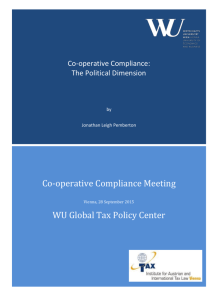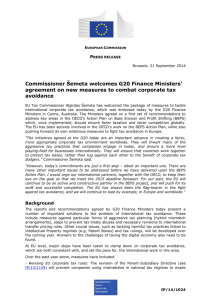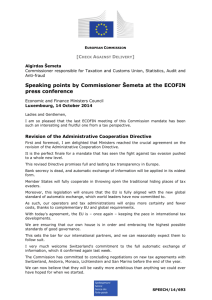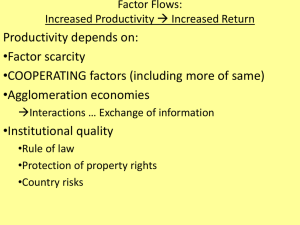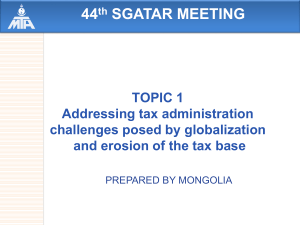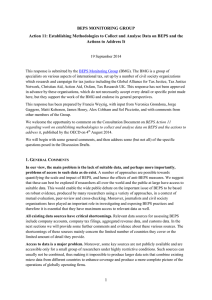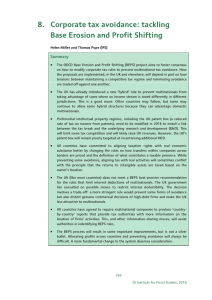Andrea Lemgruber
advertisement
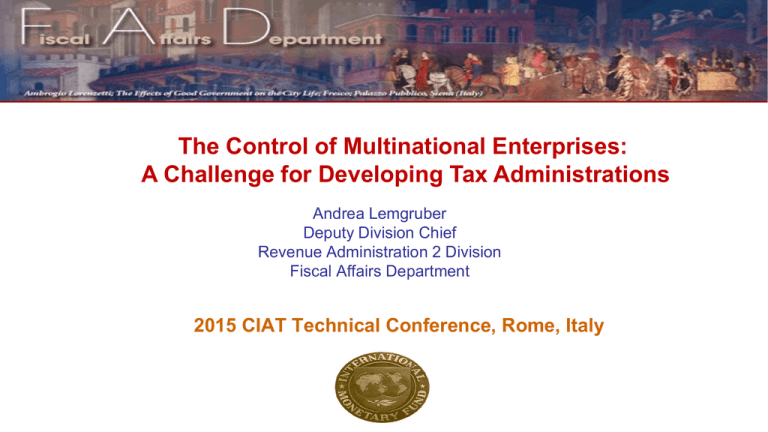
The Control of Multinational Enterprises: A Challenge for Developing Tax Administrations Andrea Lemgruber Deputy Division Chief Revenue Administration 2 Division Fiscal Affairs Department 2015 CIAT Technical Conference, Rome, Italy Outline • A brief profile of MNEs • The current debate on international taxation: what is not working? • BEPS and the collaborative effort to improve the international tax framework • Some administrative challenges to implement the BEPS action plan A Brief Profile of MNEs A Brief Profile of MNEs GDP for countries Revenue for MNEs (all in US trillion) 20 18 16 14 12 10 8 6 4 2 Sources: IMF and www.statista.com 0 US China 20 MNE Japan Germany UK A Brief Profile of MNEs Top 100 Companies by Market Capitalization, 2015 Spain 2% Japan 2% Others 8% Swiss 3% Australian 3% French 4% German 6% American 53% British 8% Chinese 11% Source: PwC 2015 Global 100 companies A Brief Profile of MNEs A Brief Profile of MNEs Out of companies over $100 billion in revenues… Oil and Gas … … Natural Resources Taxation in Developing Countries Source: McKinsey (2010) An Illustration of the Role of US Multinational Companies in the American Economy 1% • share of the total number of US companies accounted for by US multinationals 19% • share of the private sector work force employed by US multinationals 23% • share of the US private sector GDP accounted for by US multinationals 25% • share of total US private sector gross profits earned by US multinationals 37% • multinational's share of total US goods imports 48% • multinational's share of total US goods exports 74% • share of the US private sector R&D spending made by US multinationals 90% • share of US multinational's intermediate inputs purchased from other US-based firms The current debate on international taxation • Taxation at the forefront of the public debate • Debate on taxation is NOT NEW… • …and reflects interplay of various factors – Business and technology: digital and PE; financial engineering and equity/debt (interest deduction) – Policy design: incentives schemes, 3,000 treaties, intangibles – Administrative: limitations on EOI; weak procedures (e.g. sanctions, dispute resolution); transparency – Geo-political: promotion of international insertion of companies The current debate on international taxation Implications from aggressive international tax avoidance: • • • • Reduces government revenues Increases tax administration costs Undermines perception of integrity (overall compliance) Distorts location of investment The current debate on international taxation Some recent papers: • CIT losses not negligible and seem more relevant for developing countries IMF (2015): estimated losses due to BEPS around 0.9% GDP (OECD economies) and 1.2% GDP (developing countries) • Current international framework is weak and outdated IMF (2013 and 2014) The current debate on international taxation International framework is weak and outdated Digital; global and virtual presence; high on intellectual property “Bricks and Mortar”; physical presence; low intangibles Apple Case Established in 1977 #33 in 2009 #1 in 2015 Market Cap What means “being global”? Not only selling globally… …but also producing globally. The current debate on international taxation A picture summarizing the public discussion (and perception) nowadays BEPS Project and Collaborative Effort • “Global Problems = Global Solutions” • OECD/G-20 BEPS project – 15 action plans – Different levels of “bindingness”: minimum standards, common approaches, guidance based on best practices – Final phase before presentation to G20 leaders • Welcome initiative to advance the international debate, aiming at coordinated action • Implementation: next phase…challenges Challenges of Implementation • Developing countries: heterogeneity; different capacity levels • Relevant issues for developing countries: – Who? Wider and deeper discussion on costs and benefits of implementing BEPS agenda in developing countries – How? Revisions will require changes in domestic law (CFC rules, hybrid mismatches, country by country reports); cross-country consistency is a challenge – What is (is not) included in the BEPS agenda? (e.g. managing expectations, public debate) – Monitoring? (E.g. peer review, associated costs, coordination across countries) Challenge 1: Ensure the administration of international tax operations is embedded in a coherent, sound, and wider policy/procedural design The design of the tax system sets the base of good tax administration • The internalization of BEPS agenda: requires coordination and political will • BEPS agenda can only effectively work if the faulty design of current tax systems is addressed, such as: Complexity arising from exceptional regimes (e.g. incentives for FDI attraction, network of treaties, stability clauses for natural resource companies) Weak and incoherent legal administrative frameworks (e.g. lack of/poor tax procedures code, weak legal powers, special rules for natural resources companies: different payment rules, different rules for dispute resolution). Challenge 2: Implement BEPS agenda in a sustainable way that is supportive of foundational tax administration reforms Fundamental administrative reforms is the building block for improved overall tax administration, including the control of international operations • Avoid the risk of implementing short-term solutions (e.g. outsourcing) • BEPS should be part of a MT TA engagement that builds capacity: Recognize that the control of an MNE cannot be dissociated from the overall control a tax administration is able to exercise over the universe of taxpayers Develop HR, infrastructure, and analytical capacity in tax administration (e.g. EOI is as good as the quality of the information being exchanged, processing capacity, and effective use of information) Build on and enhance tax administrations’ approaches to segmentation and risk management Distribution of Taxpayers by Size and International Exposure (Illustrative) International Exposure Global International Domestic Small Medium Size of Taxpayers *Each dot represents 1% of the taxpaying population Large Revenue Distribution by Major Tax Categories in Low Income Countries 7.00% Tax revenue as a prcentage of GDP 6.00% 5.00% 4.00% 3.00% 2.00% 1.00% 0.00% 2004 2005 2006 Taxes on goods and services 2007 Social security 2008 2009 Taxes on international trade 2010 2011 Personal income tax 2012 2013 Corporate income tax 2014 Challenge 3: Initiate an inclusive discussion on specific issues and circumstances faced by developing countries • BEPS implementation will provide an excellent opportunity to: Discuss initiatives to help countries assess their overall tax systems and formulate wider tax reform priorities (e.g. IMF/WB initiative) Discuss whether more objective and/or specific measures for developing countries are needed (e.g. transfer pricing, natural resource sector) Challenge 4: Improve developing countries’ ownership and capacity to manage reforms • Tax authorities will need to interact with different stakeholders to build political consensus: at the domestic front (e.g. lawmakers, judicial system, business associations, MNEs, media) at the international level (e.g. TA providers, international and regional organizations, other administrations, donors). • However, capacity and resource constraints to manage reforms should not be underestimated. Conclusions • Relevance of BEPS initiative • Next step: effective and inclusive implementation is critical for success – Current misaligned incentives will not change overnight – Changes require broader political consensus – Improving capacity of tax administrations in developing countries requires time, resources, coordinated efforts – Identification/clarification of benefits and costs to developing countries Controlling MNEs is part of the overall compliance control exercised by a tax administration Controlling MNEs is controlling both its international and domestic transactions A successful implementation will depend on: Cooperation, Inclusiveness, and Coordination Thank you alemgruber@imf.org
